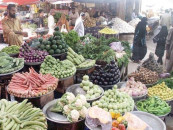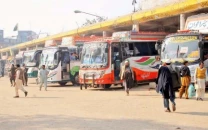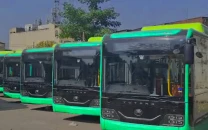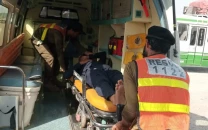Rescuing a river: Art installations highlights River Ravi pollution
Research project undertaken around degraded ecology of River Ravi

PHOTO: twitter.com/LBF2016
The Tentative Collective has installed two projections on the bank of the River Ravi to highlight the waste dumped into the watercourse.
Under the project titled: The Gandi Engine Commission, the collective took a group of 30 people late on Sunday to one of non-functional water treatment plants near the river.
“The work that you see is part of a larger project that we have undertaken in collaboration with Lahore Biennale Foundation. This was a research project undertaken around the degraded ecology of River Ravi. The term gandi (dirty) engine comes from the drains that dump sewage into the river,” said Zahra Malkani of the Tentative Collective.

“We learnt after visiting the sites that these outlets are colloquially referred to as gandi engine by residents of the area,” said Shahana Rajani, a member of the collective. “We instantly started scouting out these engines around the city. We chose this site because there is a warehouse opposite it which has iron and steel parts that come from the Gadani ship-breaking yard,” she said.
She said that the entire lane was full of such storage yards. “Old ships from Western countries come to Gadani to be broken down. It is a form of toxic colonialism. Their metal makes its way to the Punjab. The steel industry then buys them and recycles the debris of these ships to sustain development. This completes a historical cycle,” she said.
The two projections are across the road from one another. The projection at the Gandi engine was of a ship at Gadani, with an Urdu quote projected on the sidewall. It translates as: Waste and wasted lives are the inevitable debris of modernity. The projection at the metal warehouse across the street is a video showing sewage water flowing into the river from the gandi engine. The Urdu text projected on the ceiling of the warehouse translates as: These ruins of imperialism are still alive. “We wanted people to think about these issues. The text helps with that,” said Rajani.
“The work is a visual articulation of our research. It’s part of a series of work we produced earlier in the year titled projections. It was displayed in Karachi,” said Malkani. “These projections are ephemeral. They do not call for a prolonged engagement from the audience but something that you just walk past. They alter your experience of space in that particular moment,” she said.
“I think the Lahore Biennale Foundation is a great initiative. I loved the idea when I heard about this project. Someone was just asking why they did not start at another place which had more garbage. I think it is better to start at a small scale because it is not easy to bring about a sudden change on a grand scale. What surprises me the most is the reaction of the people who stop and view the projections,” said Huma Tasawur, an artist from the Goethe Institut, Karachi.
Published in The Express Tribune, September 22nd, 2015.



















COMMENTS
Comments are moderated and generally will be posted if they are on-topic and not abusive.
For more information, please see our Comments FAQ